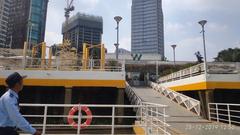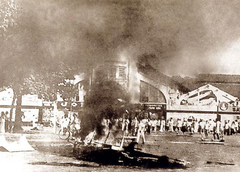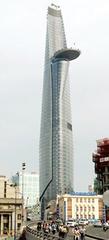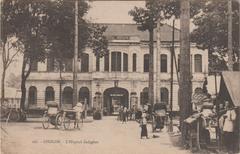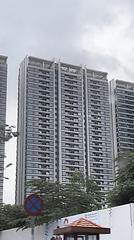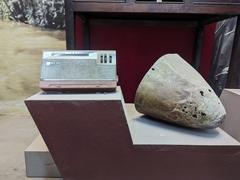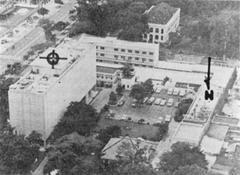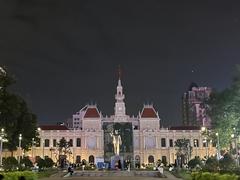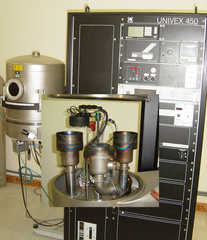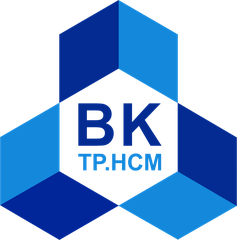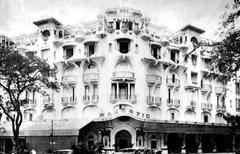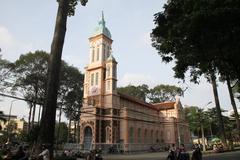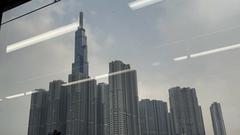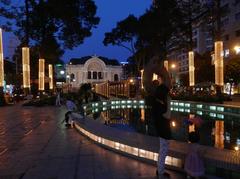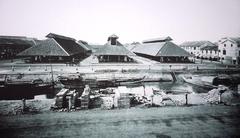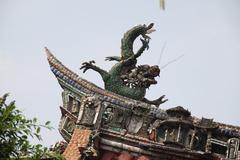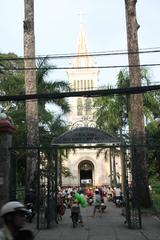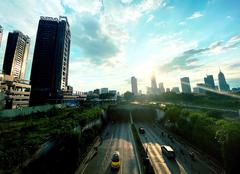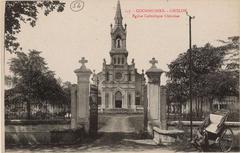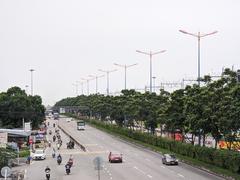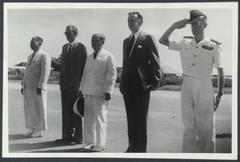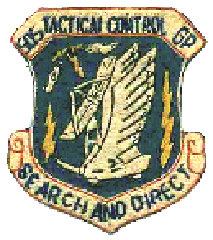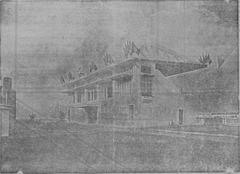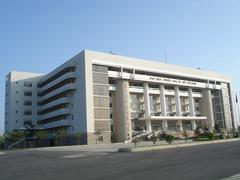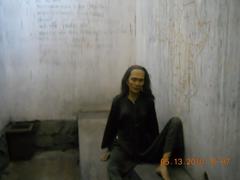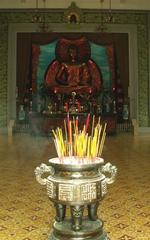
Hùng King Temple in Ho Chi Minh City: Visiting Hours, Tickets, and Historical Significance
Date: 03/07/2025
Introduction
Nestled in the heart of District 1 and surrounded by the lush Saigon Zoo and Botanical Gardens, the Hùng King Temple is a remarkable symbol of Vietnam’s enduring cultural identity and national heritage. Originally constructed as a memorial to Vietnamese soldiers lost in World War I, this temple now stands as a living monument to the legendary Hùng Kings—mythical founders of Vietnam. Its unique blend of traditional Vietnamese architectural elements and colonial influences, coupled with its central role in annual festivals and daily worship, makes it one of the most significant historical and spiritual sites among Ho Chi Minh City historical attractions (historicvietnam.com; saigoneer.com).
This guide provides detailed information on the temple’s history, architecture, visiting hours, tickets, accessibility, notable features, annual events, and practical travel tips—offering everything you need to plan a meaningful visit.
Historical Background
Origins and Early History
The Hùng King Temple was built between 1927 and 1929, originally named the Temple du Souvenir Annamite. It served as a memorial to the Vietnamese soldiers who fought and died in World War I, reflecting the wishes of Saigon’s Vietnamese community for a monument rooted in local spiritual traditions rather than a Western-style cenotaph. The site’s transformation over the decades mirrors Vietnam’s evolving historical consciousness and national priorities (historicvietnam.com).
Rededication and Evolution
In 1955, the temple was officially rededicated to the Hùng Kings—legendary rulers believed to have founded the Vietnamese nation. Since 1975, the temple’s focus has been exclusively on these ancestral figures, making it an important pilgrimage site during the annual Hùng Kings Commemoration Day and other cultural events.
Architectural Highlights
Exterior and Setting
Designed by French architect Auguste Delaval, the temple fuses traditional Vietnamese elements with colonial-era influences. The grand staircase, guarded by stylized dragon sculptures, leads to a raised platform and reflects the symmetry of Nguyễn dynasty mausoleums. The roof’s upturned eaves, adorned with dragons and phoenixes, symbolize power, harmony, and national resilience.
A prominent feature in the courtyard is the three-ton bronze elephant statue, a gift from King Rama VII of Thailand in 1930, representing regional friendship and historical ties (saigoneer.com; historicvietnam.com).
Interior
Inside the temple, visitors encounter a spacious main hall with a central shrine dedicated to the Hùng Kings. The hall is adorned with bronze-tipped weapons, a gong, a drum, and replica Đông Sơn drums—evoking Vietnam’s ancient martial heritage. Artifacts like a model of the main Hùng King Temple in Phú Thọ Province provide a visual link to the original site.
Traditional motifs, such as lotuses, cranes, and stylized clouds, embellish the woodwork, while calligraphic panels express messages of reverence and gratitude. Natural light, filtered through windows and skylights, adds to the contemplative and spiritual atmosphere.
Integration with Nature
Set within the botanical gardens, the temple’s design harmonizes with its natural surroundings, offering tranquil spaces for reflection and connecting visitors with both cultural and environmental heritage (vietnamlife.asia).
Visiting Hours, Tickets, and Access
Visiting Hours
- General Hours: Daily, 7:00 AM – 5:00 PM (trip.com)
- Special Opening (per some sources): 8:00–11:30 and 13:00–17:00 on the 1st, 15th, and 30th days of the lunar month.
Ticket Information
- Temple Admission: Free for all visitors.
- Zoo Entrance Fee: Since the temple is located within the Saigon Zoo and Botanical Gardens, a zoo entry ticket is required—approximately 40,000 VND for adults and 20,000 VND for children.
- Tickets for Museum of Vietnamese History: Some tours recommend purchasing tickets at the nearby museum for a broader experience.
Location and Directions
- Address: Saigon Zoo and Botanical Gardens, 2A Mai Thị Lựu Street, District 1, Ho Chi Minh City.
- Access: Reachable by taxi, motorbike, or public buses serving District 1. The site is adjacent to other major attractions, including the Museum of Vietnamese History and the Independence Palace.
Accessibility
- The temple is mostly wheelchair accessible, with ramps and paved pathways.
- Some areas have stairs or uneven surfaces; visitors with mobility challenges should plan accordingly.
- Restrooms and cafes are available within the zoo complex.
Notable Features and Artifacts
- Bronze Elephant Statue: Gifted by King Rama VII of Thailand.
- Replica Đông Sơn Drums: Symbolizing Vietnam’s ancient civilization.
- Model of Phú Thọ Temple: Linking the site to the original Hùng Kings worship complex.
- Ornate Roof Tiles and Reliefs: Showcasing early 20th-century craftsmanship.
- Traditional Calligraphy and Motifs: Reflecting longevity, wisdom, and harmony.
Cultural and Spiritual Significance
The Hùng Kings in Vietnamese Identity
The Hùng Kings, mythic descendants of Lạc Long Quân and Âu Cơ, are credited as the founders of the Văn Lang Kingdom, the earliest known Vietnamese state (c. 2879–258 BC). Their legacy is central to national consciousness and is celebrated annually during the Hùng Kings Festival—recognized by UNESCO as an Intangible Cultural Heritage of Humanity (vinwonders.com; vietnamplus.vn).
Worship, Rituals, and Festivals
The temple is a focal point for ancestral veneration, most notably during the Hùng Kings’ Festival (10th day of the third lunar month, April 7, 2025). Ceremonies include incense offerings, processions, traditional music, dance, and folk games, fostering unity and connecting generations (Asia Legend Travel).
National Solidarity
The practice of “uống nước nhớ nguồn” (“drinking water, remembering the source”) is at the heart of Vietnamese culture and is embodied in the rituals and educational activities at the temple. The site is a place for both locals and the Vietnamese diaspora to reaffirm identity and gratitude.
Special Events and Educational Activities
- Hùng Kings’ Festival: The temple is adorned with banners and lanterns, hosting large crowds and vibrant cultural performances.
- Educational Tours: Available through local operators, providing historical context and insight into Vietnamese mythology and spirituality.
- Workshops and Exhibitions: Folk games, traditional music, and displays on Vietnamese heritage, especially engaging for young visitors.
Practical Visitor Tips
- Dress Code: Wear modest clothing covering shoulders and knees.
- Etiquette: Maintain silence and respect during worship. Ask permission before taking photos of ceremonies or individuals.
- Best Times: Early mornings or festival dates for unique experiences; weekdays for fewer crowds.
- Facilities: Restrooms and cafes within the zoo; souvenir stalls sell incense and small gifts.
Nearby Attractions
- Saigon Zoo and Botanical Gardens: One of Asia’s oldest zoos, with diverse flora and fauna.
- Museum of Vietnamese History: Offers a rich overview of the nation’s past.
- Notre Dame Cathedral and Central Post Office: Iconic French colonial landmarks nearby (Nomadic Matt).
Frequently Asked Questions (FAQs)
Q: What are the Hùng King Temple visiting hours?
A: Generally 7:00 AM to 5:00 PM daily; also open 8:00–11:30 and 13:00–17:00 on the 1st, 15th, and 30th of the lunar month.
Q: Is there an entrance fee?
A: The temple is free, but entry to the Saigon Zoo and Botanical Gardens requires a ticket.
Q: Are guided tours available?
A: Yes, local operators and cultural centers offer tours.
Q: Is the temple wheelchair accessible?
A: Mostly yes, though some areas have stairs or uneven paths.
Q: When is the best time to visit?
A: Early mornings or during the Hùng Kings’ Festival (early April, lunar calendar).
Visitor Recommendations
- Combine your visit with the Museum of Vietnamese History and other District 1 attractions for a comprehensive cultural experience.
- Plan ahead for festival dates, as the temple can become crowded.
- Download the Audiala app for up-to-date guides, virtual tours, and local event notifications.
Sources
- historicvietnam.com
- saigoneer.com
- scootersaigontour.com
- trip.com
- vinwonders.com
- vietnamplus.vn
- vietnamlife.asia
- Asia Legend Travel
- VietnamOnline
- Nomadic Matt


